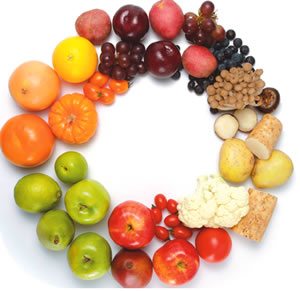Eating Rainbows
Choosing colorful foods leads to healthy diets
By Joan Daniels, R.D., and
Nancy Burke, R.D.
When you were a kid, you wanted the big box of crayons, the one with the most colors. You wouldn't have dreamed of drawing a picture in drab neutrals.

The same rule should apply to your dinner plate. Don't settle for the boring browns of meat, the beige blahs of potato chips and the worthless whites of refined carbohydrates, like white bread, white rice and white sugar. Paint your plates with fruits and vegetables in a variety of colors. Color often signifies valuable nutrients that can help in fighting cancer. We've put together a color wheel to help you learn about the phytochemicals -- or plant chemicals -- that may be beneficial to you. Although we don't fully understand how these chemicals work individually, we do know that eating a well-rounded diet by combining a variety of colorful fruits, vegetables and legumes creates a synergistic effect that helps to promote good health and lower disease risk.
Red: tomatoes, watermelon, pink grapefruit, guava, papaya, cranberries
Lycopene, an antioxidant that may help to protect against cancers of the prostate, stomach and lung, lends some fruits and vegetables their reddish cast. Foods that are high in lycopene -- including tomatoes -- have been linked to lower risk of cancer and heart attacks. Cooked tomato sauce is an especially great source of lycopene, as the cooking helps the body to absorb carotenoids more easily.
Orange: carrots, mangos, cantaloupe, winter squash, sweet potatoes, pumpkins, apricots
Orange-colored foods may contain beta-cryptoxanthin, beta-carotene and alpha-carotene, nutrients that can be converted into vitamin A. The beta-carotenes in some orange fruits and veggies also may play a role in reducing risk of lung, esophagus and stomach cancers.
Brown: beans, chickpeas, lentils
Nope, we're not talking about a big hunk of meat. Lentils, black beans and chickpeas can play a big role in preventing heart disease. They are all full of folate, a B vitamin that counteracts homocysteine, an amino acid that can help blood clots to form.
Green: broccoli, cabbage, bok choy, brussels sprouts
Cruciferous vegetables, such as broccoli and cabbage, are rich in isothiocyanates and indoles -- two phytochemicals that may have anticancer properties. Leafy green vegetables also have been linked to reduced risk of heart disease. Green vegetables are powerhouses of nutrients; they're also packed with folic acid, vitamin K, carotenoids and omega-3 fatty acids.
Purple: blueberries, eggplant, blackberries, prunes, plums, pomegranates, beets, purple cabbage
Purple and blue fruits and vegetables draw their color from anthocyanin, an antioxidant. The antiinflammatory properties of anthocyanin may be beneficial for lowering risk for cancer and heart disease, while also lessening the painful effects of arthritis.
Continue reading the Winter, 2010 issue of Thrive.
Continue learning about the benefits of organic food and fresh vegetables
Tips for Buying Superfoods and Prepping Veggies
Preparing Foods With Antioxidants
Plant-based Diets: Why all the hype?
Nutrition and Cancer Prevention
